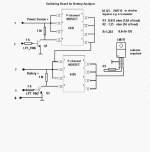Oops! Forgot to post up "Step 3"
Step 1 - Bulk Charging
Step 2 - Comparative IR (Quick Condition-Capacity Estimate)
Step 3 - Bulk Discharge-Capacity Testing
"Batch" cells of similar manufacture capacity and "comparative IR".
a. Rig as 30s = 126V, (tabbed as 2p = 60 cells per batch - 3p = 90 - 4p = 120), or 28 x 4.2V = 117.6V DC , and discharge with 2x60w light bulbs 120W / ~120V = 1000mAh per hour for accurate capacity (3 hours discharge = 3000mAh + remaining voltage (EG 3000mAh + 3.75V)).
Cells can be rated by discharged mAh + remaining voltage or further discharging individual pairs using metered discharge device (3000mAh + 1458mAh = 4458mAh saves 3 hour per additional pair)
or
b. Rig as ≤20s and discharge using a cheap V-A-mAh meter using discharge source, multiple light bulbs? (meter requires external power supply to retain readings while cells being removed)
See -
Bulk Capacity Testing for full and various testing methods.
Even a 2 hour discharge, + the remaining voltage, is sufficient to build a fairly balanced pack.
Line up all cell pairs, best to worst.
Starting with best, lay them into banks ...
12s = ...
1 2 3 4 5 6 7 8 9 10 11 12 12 11 10 9 8 7 6 5 4 3 2 1 1 2 3 4 5 6 7 8 9 10 11 12 etc
9s = ...
1 2 3 4 5 6 7 8 9 9 8 7 6 5 4 3 2 1 1 2 3 4 5 6 7 8 9 9 8 7 6 5 4 3 2 1 etc
etc.
Unless you have a few exceptionally good or bad cells, this should build banks of nearly identical capacity.
Reshuffling ... adding or subtracting cells from any variant bank can "tune-up a pack easily!
If using various brands, try to distribute a representative sampling of each into every bank.
This helps banks retain a reasonably equal IR - important for building a battery that doesn't need a BMS to maintain equalized banks.
Cheap - ~$12 IR meter, V-A-mAh meters etc - See -
EBike Toolbox - Bargains! $



